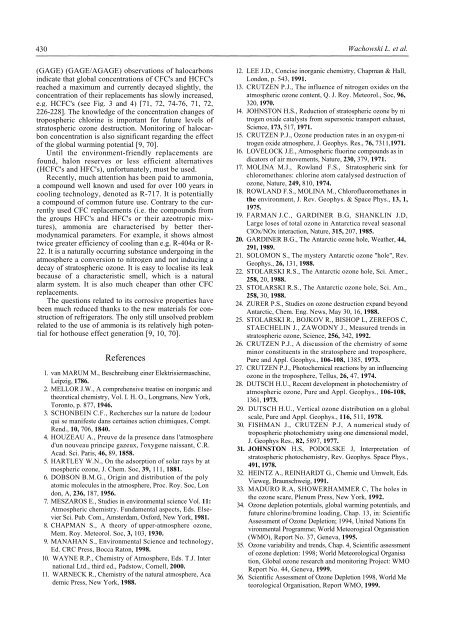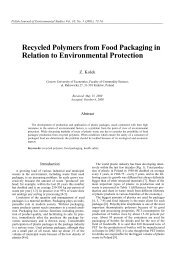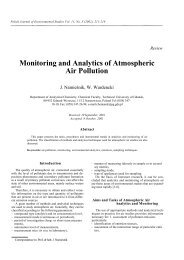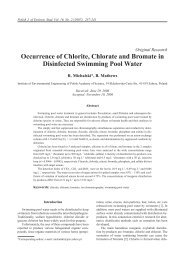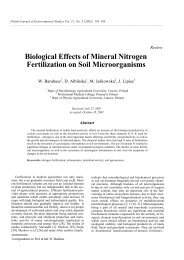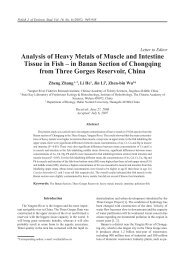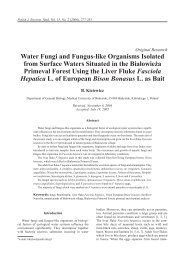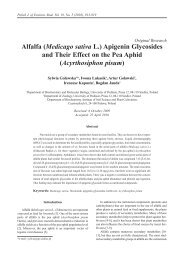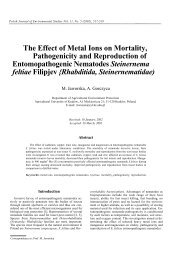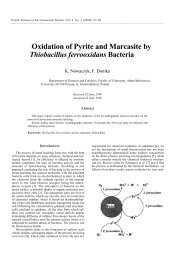Ecological Replacements of Ozone-Depleting Substances
Ecological Replacements of Ozone-Depleting Substances
Ecological Replacements of Ozone-Depleting Substances
You also want an ePaper? Increase the reach of your titles
YUMPU automatically turns print PDFs into web optimized ePapers that Google loves.
430 Wachowski L. et al.<br />
(GAGE) (GAGE/AGAGE) observations <strong>of</strong> halocarbons<br />
indicate that global concentrations <strong>of</strong> CFC's and HCFC's<br />
reached a maximum and currently decayed slightly, the<br />
concentration <strong>of</strong> their replacements has slowly increased,<br />
e.g. HCFC's (see Fig. 3 and 4) [71, 72, 74-76, 71, 72,<br />
226-228]. The knowledge <strong>of</strong> the concentration changes <strong>of</strong><br />
tropospheric chlorine is important for future levels <strong>of</strong><br />
stratospheric ozone destruction. Monitoring <strong>of</strong> halocarbon<br />
concentration is also significant regarding the effect<br />
<strong>of</strong> the global warming potential [9, 70].<br />
Until the environment-friendly replacements are<br />
found, halon reserves or less efficient alternatives<br />
(HCFC's and HFC's), unfortunately, must be used.<br />
Recently, much attention has been paid to ammonia,<br />
a compound well known and used for over 100 years in<br />
cooling technology, denoted as R-717. It is potentially<br />
a compound <strong>of</strong> common future use. Contrary to the currently<br />
used CFC replacements (i.e. the compounds from<br />
the groups HFC's and HFC's or their azeotropic mixtures),<br />
ammonia are characterised by better thermodynamical<br />
parameters. For example, it shows almost<br />
twice greater efficiency <strong>of</strong> cooling than e.g. R-404a or R-<br />
22. It is a naturally occurring substance undergoing in the<br />
atmosphere a conversion to nitrogen and not inducing a<br />
decay <strong>of</strong> stratospheric ozone. It is easy to localise its leak<br />
because <strong>of</strong> a characteristic smell, which is a natural<br />
alarm system. It is also much cheaper than other CFC<br />
replacements.<br />
The questions related to its corrosive properties have<br />
been much reduced thanks to the new materials for construction<br />
<strong>of</strong> refrigerators. The only still unsolved problem<br />
related to the use <strong>of</strong> ammonia is its relatively high potential<br />
for hothouse effect generation [9, 10, 70].<br />
References<br />
1. van MARUM M., Beschreibung einer Elektrisiermaschine,<br />
Leipzig, 1786.<br />
2. MELLOR J.W., A comprehensive treatise on inorganic and<br />
theoretical chemistry, Vol. I. H. O., Longmans, New York,<br />
Toronto, p. 877, 1946.<br />
3. SCHONBEIN C.F., Recherches sur la nature de l;odour<br />
qui se manifeste dans certaines action chimiques, Compt.<br />
Rend., 10, 706, 1840.<br />
4. HOUZEAU A., Preuve de la presence dans l'atmosphere<br />
d'un nouveau principe gazeux, l'oxygene naissant, C.R.<br />
Acad. Sci. Paris, 46, 89, 1858.<br />
5. HARTLEY W.N., On the adsorption <strong>of</strong> solar rays by at<br />
mospheric ozone, J. Chem. Soc, 39, 111, 1881.<br />
6. DOBSON B.M.G., Origin and distribution <strong>of</strong> the poly<br />
atomic molecules in the atmosphere, Proc. Roy. Soc, Lon<br />
don, A, 236, 187, 1956.<br />
7. MESZAROS E., Studies in environmental science Vol. 11:<br />
Atmospheric chemistry. Fundamental aspects, Eds. Elsevier<br />
Sci. Pub. Com., Amsterdam, Oxford, New York, 1981.<br />
8. CHAPMAN S., A theory <strong>of</strong> upper-atmosphere ozone,<br />
Mem. Roy. Meteorol. Soc, 3, 103, 1930.<br />
9. MANAHAN S., Environmental Science and technology,<br />
Ed. CRC Press, Bocca Raton, 1998.<br />
10. WAYNE R.P., Chemistry <strong>of</strong> Atmosphere, Eds. T.J. Inter<br />
national Ltd., third ed., Padstow, Cornell, 2000.<br />
11. WARNECK R., Chemistry <strong>of</strong> the natural atmosphere, Aca<br />
demic Press, New York, 1988.<br />
12. LEE J.D., Concise inorganic chemistry, Chapman & Hall,<br />
London, p. 543, 1991.<br />
13. CRUTZEN P.J., The influence <strong>of</strong> nitrogen oxides on the<br />
atmospheric ozone content, Q. J. Roy. Meteorol., Soc, 96,<br />
320, 1970.<br />
14. JOHNSTON H.S., Reduction <strong>of</strong> stratospheric ozone by ni<br />
trogen oxide catalysts from supersonic transport exhaust,<br />
Science, 173, 517, 1971.<br />
15. CRUTZEN P.J., <strong>Ozone</strong> production rates in an oxygen-ni<br />
trogen oxide atmosphere, J. Geophys. Res., 76, 7311,1971.<br />
16. LOVELOCK J.E., Atmospheric fluorine compounds as in<br />
dicators <strong>of</strong> air movements, Nature, 230, 379, 1971.<br />
17. MOLINA M.J., Rowland F.S., Stratospheric sink for<br />
chloromethanes: chlorine atom catalysed destruction <strong>of</strong><br />
ozone, Nature, 249, 810, 1974.<br />
18. ROWLAND F.S., MOLINA M., Chlor<strong>of</strong>luoromethanes in<br />
the environment, J. Rev. Geophys. & Space Phys., 13, 1,<br />
1975.<br />
19. FARMAN J.C., GARDINER B.G, SHANKLIN J.D,<br />
Large loses <strong>of</strong> total ozone in Antarctica reveal seasonal<br />
ClOx/NOx interaction, Nature, 315, 207, 1985.<br />
20. GARDINER B.G., The Antarctic ozone hole, Weather, 44,<br />
291, 1989.<br />
21. SOLOMON S., The mystery Antarctic ozone "hole", Rev.<br />
Geophys., 26, 131, 1988.<br />
22. STOLARSKI R.S., The Antarctic ozone hole, Sci. Amer.,<br />
258, 20, 1988.<br />
23. STOLARSKI R.S., The Antarctic ozone hole, Sci. Am.,<br />
258, 30, 1988.<br />
24. ZURER P.S., Studies on ozone destruction expand beyond<br />
Antarctic, Chem. Eng. News, May 30, 16, 1988.<br />
25. STOLARSKI R., BOJKOV R., BISHOP L, ZEREFOS C,<br />
STAECHELIN J., ZAWODNY J., Measured trends in<br />
stratospheric ozone, Science, 256, 342, 1992.<br />
26. CRUTZEN P.J., A discussion <strong>of</strong> the chemistry <strong>of</strong> some<br />
minor constituents in the stratosphere and troposphere,<br />
Pure and Appl. Geophys., 106-108, 1385, 1973.<br />
27. CRUTZEN P.J., Photochemical reactions by an influencing<br />
ozone in the troposphere, Tellus, 26, 47, 1974.<br />
28. DUTSCH H.U., Recent development in photochemistry <strong>of</strong><br />
atmospheric ozone, Pure and Appl. Geophys., 106-108,<br />
1361, 1973.<br />
29. DUTSCH H.U., Vertical ozone distribution on a global<br />
scale, Pure and Appl. Geophys., 116, 511, 1978.<br />
30. FISHMAN J., CRUTZEN P.J, A numerical study <strong>of</strong><br />
tropospheric photochemistry using one dimensional model,<br />
J. Geophys Res., 82, 5897, 1977.<br />
31. JOHNSTON H.S, PODOLSKE J, Interpretation <strong>of</strong><br />
stratospheric photochemistry, Rev. Geophys. Space Phys.,<br />
491, 1978.<br />
32. HEINTZ A., REINHARDT G., Chemie und Umwelt, Eds.<br />
Vieweg, Braunschweig, 1991.<br />
33. MADURO R.A, SHOWERHAMMER C, The holes in<br />
the ozone scare, Plenum Press, New York, 1992.<br />
34. <strong>Ozone</strong> depletion potentials, global warming potentials, and<br />
future chlorine/bromine loading, Chap. 13, in: Scientific<br />
Assessment <strong>of</strong> <strong>Ozone</strong> Depletion; 1994, United Nations En<br />
vironmental Programme; World Meteorogical Organisation<br />
(WMO), Report No. 37, Geneva, 1995.<br />
35. <strong>Ozone</strong> variability and trends, Chap. 4, Scientific assessment<br />
<strong>of</strong> ozone depletion: 1998; World Meteorological Organisa<br />
tion, Global ozone research and monitoring Project: WMO<br />
Report No. 44, Geneva, 1999.<br />
36. Scientific Assessment <strong>of</strong> <strong>Ozone</strong> Depletion 1998, World Me<br />
teorological Organisation, Report WMO, 1999.


